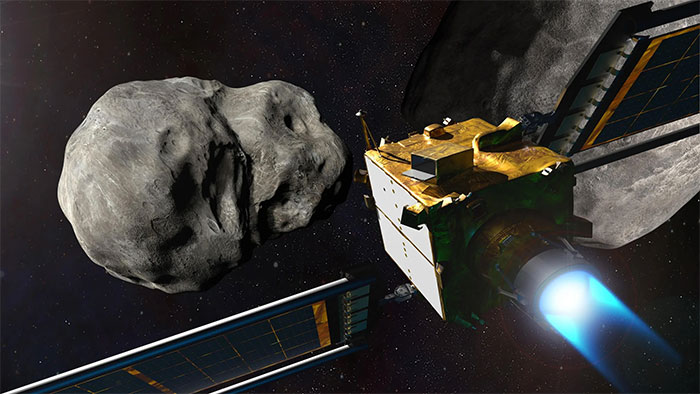Did NASA's Dart spacecraft indirectly bombard other planets?
The suicide dive of the NASA spacecraft named DART caused such a strong impact that our neighboring planet was also "hit" .
A new analysis has revealed that some rocks from the asteroid Dimorphos that NASA's DART spacecraft crashed into in 2022 may be on a collision course with Mars , our neighboring planet, according to Science Alert.

Impact craters up to 300m in diameter may appear on the red planet due to indirect impacts from the DART ship's dive - (AI graphic image)
DART was the spacecraft used in the Twin Asteroid Redirection Test (DART ), in which the smaller asteroid in the Didymos - Dimorphos near-Earth pair was slammed into by DART.
This is a test with a hypothetical scenario that Dimorphos is capable of impacting Earth, in preparation for real threats in the future.
Since then, NASA and partner space agencies have always monitored this impact.

The DART ship plunged into Dimorphos - (Graphic photo: NASA).
The research team led by astronomer Marco Fenucci from the European Space Agency (ESA) and Albino Carbognani from the Italian National Institute of Astrophysics pointed out the possibility of Mars "taking a hit" in a recently published report. Published in the scientific journal Monthly Notices of the Royal Astronomical Society.
Their investigation focused on numerical simulations of the impact, revealing impacts from now up to 20,000 years from now, with a particular focus on 37 rocks identified by the Hubble Space Telescope, Measures from 4-7 m.
You will feel relieved to know that Earth is fine. Some rocks come close, but close enough to pose a threat.
But four of the rocks will come close enough to Mars to crash into the surface – two within 6,000 years from now and two in 15,000 years.
If those small rocks hit Earth, they would quickly be burned up by the atmosphere and could disappear long before reaching the surface. But Mars is not protected by an atmospheric cushion as well as Earth.
According to calculations, they can create small craters with a diameter of up to 300 m on our neighboring planet.
That doesn't seem like a big deal at the moment, because there's no one on Mars right now.
But if space agencies launch missions targeting Mars in the future, they will need to consider the risk to spacecraft at the moment these rocks intersect Mars' orbit.
- NASA is about to attack asteroids that harm the Earth
- Reveal secrets to hundreds of hundreds of victories in a dart throw
- Detecting the outer three planets about the size of the Earth
- Kepler discovered 20 Earth-like planets that could contain life
- Japanese experimental space bombs shoot meteors
- Bird flu can spread indirectly
- Discover a new poisonous frog in Panama
- The meteorite is as big as a mountain rushing towards Earth
- NASA's $ 3.3 billion spacecraft is about to commit suicide on Saturn
- NASA is about to crash a $ 330 million spacecraft into an asteroid
- Beware of deadly beautiful frogs
- The distance from the Earth to the celestial bodies in the solar system
 Van Allen's belt and evidence that the Apollo 11 mission to the Moon was myth
Van Allen's belt and evidence that the Apollo 11 mission to the Moon was myth The levels of civilization in the universe (Kardashev scale)
The levels of civilization in the universe (Kardashev scale) Today Mars, the sun and the Earth are aligned
Today Mars, the sun and the Earth are aligned The Amazon owner announced a secret plan to build a space base for thousands of people
The Amazon owner announced a secret plan to build a space base for thousands of people Revealing the first city on Mars, with enough space for more than 250,000 people to live
Revealing the first city on Mars, with enough space for more than 250,000 people to live  We could start building a colony on Mars with just 22 people!
We could start building a colony on Mars with just 22 people!  Amazing discovery of 4.5 billion year old alien ocean of life
Amazing discovery of 4.5 billion year old alien ocean of life  Mars' Surprising Effect on Earth's Oceans
Mars' Surprising Effect on Earth's Oceans  Was there nuclear war in ancient times?
Was there nuclear war in ancient times?  What happens to dead bodies on Mars?
What happens to dead bodies on Mars? 